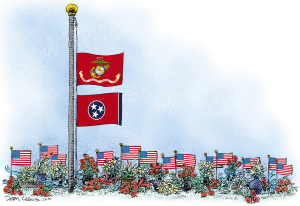
If Elizabeth Warren is President
Pharoah Morsi in Jail

Trivedi’s Cartoon Media Storm in India
Cartoonist Aseem Trivedi was released from jail in Mumbai on $100 bail and a promise that sedition charges against him would be dropped. It was interesting to watch the media storm about Trivedi explode in the middle of my speaking tour of India.

The Cartoonists Rights Network, a foundation associated with my professional organization, The Association of American Editorial Cartoonists, is giving their Courage in Cartooning award to Trivedi this weekend at our convention in Washington DC. I’ve been spending the past two weeks talking to the media in India, and early on I would get no interest or follow up questions about Trivedi – then when Trivedi went to jail it was all over the news, in banner headlines in all the newspapers and dominating TV news. All of India was outraged at the ridiculous charges and injustice of putting a cartoonist in jail for drawing symbols of the state.
I heard and read a lot of outraged opinions on the case in the media here, and I don’t recall hearing anyone argue in favor of jailing Trivedi. He got support from all corners of India, although I notice that nowhere in the media did I see anyone reprint or show the offending cartoons.
Also interesting was the motivation of journalists here to tell “both sides” of the story, but since nobody would speak in favor of jailing the cartoonist, the “other side” came out as derision, describing Trivedi as a “bad cartoonist,” and the cartoons as “terrible,” although “nothing that should land the cartoonist in jail.” I think that attitude is just plain rude. Trivedi isn’t a bad cartoonist – as regular readers of our site can see, his cartoons hold up pretty well to cartoons by other foreign cartoonists, and cartoonists from India. I think he’s a good cartoonist, and he deserves some respect for his artwork.

Trivedi also deserves some admiration for the way he handled himself through this media storm. He refused to accept bail for days, keeping the story alive and in the headlines. He’s been appearing all over the media since his release, giving interviews and making intolerant authorities here look silly. I think he’ll have a strong impact on moving India to a more free press.
There is a general rule that editorial cartoons are a barometer of freedom in any country – if cartoonists can draw the president of their country then the country has a free press. We don’t see Chinese cartoonists drawing their president; Fidel Castro is never drawn by cartoonists in Cuba. Our cartoonists in Singapore tell me that they are free to draw anything, as long as it isn’t about Singapore.
In India there is a mixed message on the cartoonist barometer. The press savages the Prime Minister, who is regularly lampooned in cartoons, but drawings of the President of India, who has a less substantive, ceremonial role, are barred. Cartoonists are forbidden by law from offending religious sensibilities – and Trivedi did well to limit his cartoons to symbols of the state, so that religious issues never came into the argument. Cartoonists in India are forbidden from drawing symbols of the state, without first getting permission from the state – that may change soon, because of Trivedi, and it is an important change. It is the role of editorial cartoonists to criticize government, and symbols of government (flags, seals, currency, government buildings like India’s Parliament building) are the prime tools in every editorial cartoonist’s tool chest.

If I couldn’t draw symbols of governments, and I was barred from offending religious sensibilities, there wouldn’t be much of substance left for me to draw.
Trivedi has done an excellent job of making his point against government corruption in India and against the absurd restrictions against cartoonists in India. He’s an excellent artist too, and at the young age of 24 he’s now India’s star cartoonist. All in all, a great result for a talented, media savvy, young activist.
John Edwards Doggie Ridiculous

Supreme Court and California Prisons

Osama And Paris Hilton

Paris Hilton WHAT

Paris Hilton Gets Out of Jail
















